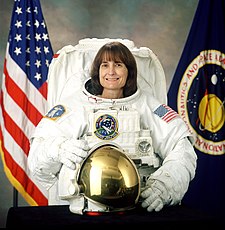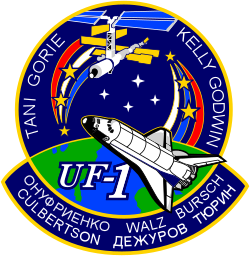Linda Godwinová
| Linda Godwinová | |
|---|---|
 Linda Godwinová | |
| Astronaut NASA | |
| Státní příslušnost | |
| Datum narození | 2. července 1952 (70 let) |
| Místo narození | Cape Girardeau, Missouri |
| Předchozí zaměstnání | vědec |
| Čas ve vesmíru | 38 dní, 06 hodin a 13 minut |
| Kosmonaut od | 1985 |
| Mise | STS-37, STS-59, STS-76, STS-108 |
| Znaky misí | |
| Kosmonaut do | 2011 |
| Pozdější zaměstnání | učitelka |
| Některá data mohou pocházet z datové položky. | |
Linda Maxine Godwinová (*2. července 1952 v Cape Girandeau, stát Missouri, USA) je americká vědkyně, učitelka a kosmonautka. Ve vesmíru byla čtyřikrát.
Život
Studium a zaměstnání
V roce 1970 zdárně ukončila střední školu Jackson High School ve městě Jackson v Missouri a poté absolvovala vysokoškolská studia na univerzitě Southeast Missouri State a University of Missouri. Zakončila je v roce 1980 získáním doktorátu v oboru fyziky a nastoupila do NASA v Houstonu.
V letech 1985 až 1986 absolvovala výcvik a poté byla zařazena do oddílu astronautů. V něm zůstala do srpna 2011. Pak se vrátila učit jako profesorka na University of Minnesota
Vdala se za Ronalda Michaela Segu, s nímž má dvě děti. Později se rozvedli.
Lety do vesmíru
Na oběžnou dráhu se v raketoplánech dostala čtyřikrát a strávil ve vesmíru 38 dní, 6 hodin a 13 minut. Absolvovala také dva výstupy do volného vesmíru (EVA), při nich v něm strávila přes 10 hodin. Byla 241. člověkem ve vesmíru, 14. ženou.
- STS-37 – Atlantis, (5. dubna 1991 – 1. dubna 1991), letový specialista
- STS-59 – Endeavour, start 9. duben 1994, přistání 20. duben 1994, velitel užitečného zařízení
- STS-76 – Atlantis, (22. března 1996 – 31. března 1996), letový specialista
- STS-108 – Endeavour (5. prosince 2001 – 17. prosince 2001), specialistka
Odkazy
Externí odkazy
 Obrázky, zvuky či videa k tématu Linda Godwinová na Wikimedia Commons
Obrázky, zvuky či videa k tématu Linda Godwinová na Wikimedia Commons - Na webu Space
- Na webu MEK-Kosmo
Média použitá na této stránce
This is the mission patch of STS-108. Space Shuttle Endeavour is seen approaching the International Space Station. Two astronaut symbols represent the crew commanders of both ISS expeditions. The ascending one represents cosmonaut Yury Onufriyenko of Russia. (The ascending astronaut symbol shows a flag of Russia.) The descending astronaut symbol represents Frank Culbertson of the USA. This represents crew rotation, as three stars are depicted on the symbols. The space shuttle crew members are depicted along the border while the ISS crews are depicted along the chevron on the border of the patch.
- This is the insignia for the STS-108 mission, which marks a major milestone in the assembly of the International Space Station (ISS) as the first designated Utilization Flight, UF-1. The crew of Endeavour will bring the Expedition Four crew to ISS and return the Expedition Three crew to Earth. Endeavour will also launch with a Multi-Purpose Logistics Module (MPLM) that will be berthed to ISS and unloaded. The MPLM will be returned to Endeavour for the trip home and used again on a later flight. The crew patch depicts Endeavour and the ISS in the configuration at the time of arrival and docking. The Station is shown viewed along the direction of flight as will be seen by the Shuttle crew during their final approach and docking along the X-axis. The three ribbons and stars on the left side of the patch signify the returning Expedition Three crew. The red, white and blue order of the ribbons represents the American commander for that mission. The three ribbons and stars on the right depict the arriving Expedition Four crew. The white, blue, red order of the Expedition Four ribbon matches the color of the Russian flag and signifies that the commander of Expedition Four is a Russian cosmonaut. Each white star in the center of the patch represents the four Endeavour crew members. The names of the four astronauts who will crew Endeavour are shown along the top border of the patch. The three astronauts and three cosmonauts of the two expedition crews are shown on the chevron at the bottom of the patch.
STS-59 crew insignia
- The STS-59 insignia is dominated by Earth, reflecting the focus of the first Space Radar Laboratory (SRL-1) mission upon our planet's surface and atmosphere. The golden symbol of the astronaut corps emblem sweeps over Earth's surface from the Space Shuttle Endeavour, representing the operation of the SIR-C/Synthetic Aperture Radar (X-SAR) and the Measurement of Air Pollution from Space (MAPS) sensors. The astronaut emblem also signals the importance of the human element in space exploration and in the study of our planet. The star field visible below Earth represents the many talents and skill of the international SRL-1 team.
Portrait astronaut Linda Godwin
STS-37 Mission Insignia
STS-76 Mission Insignia





